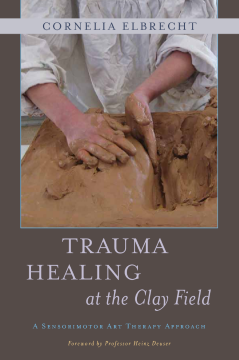
Additional Information
Book Details
Abstract
Using clay in therapy taps into the most fundamental of human experiences - touch. This book is a comprehensive step-by-step training manual that covers all aspects of 'Work at the Clay Field', a sensorimotor-based art therapy technique.
The book discusses the setting and processes of the approach, provides an overview of the core stages of Gestalt Formation and the Nine Situations model within this context, and demonstrates how this unique focus on the sense of touch and the movement of the hands is particularly effective for trauma healing in adults and children. The intense tactile experience of working with clay allows the therapist to work through early attachment issues, developmental setbacks and traumatic events with the client in a primarily nonverbal way using a body-focused approach. The kinaesthetic motor action of the hands combined with sensory perception can lead to a profound sense of resolution with lasting therapeutic benefits.
With photographs and informative case studies throughout, this book will be a valuable resource for art therapists and mental health professionals, and will also be of interest to complementary therapists and bodyworkers.
Work at the Clay Field is at the pulse of modern neuroscience. As a neuroscientist, I like the precise descriptions around haptic perception. It provides the basis for future directions in neuroscience. I would not be surprised if future research will demonstrate that haptic perception directly translates into the forming of new synapses in the brain.
Dr. Bernd Seilheimer, Head of Global Bioregulatory Development, Medical Affairs and Research, Baden-Baden, Germany
Work at the Clay Field is an important option for gaining access to psychological processes through sensory experiences that could otherwise scarcely be put into words. In particular, troubled children, barely capable of self-regulation and restraint, experience themselves in a new way at the Clay Field; they gain access to strata of their psychological experiences that facilitates fundamental stability.
Dr. Michael Günter, M.D., Professor of Child and Adolescent Psychiatry and Psychotherapy, Director of the Department of Child and Adolescent Psychiatry and Psychotherapy, University of Tübingen, Germany
This is a guidebook which details the processes of healing trauma at the Clay Field grounded in trauma research and interpersonal neurobiology. Congruent with a top down and bottom up approach in therapy with traumatized individuals, Trauma Healing at the Clay Field is a body-based intervention that offers clients experiences that address the somatic dimensions and facilitates neural integration. In my experience, this innovative art therapy approach offers a treatment intervention that is profoundly transformative for the client living with trauma.
Liz Antcliff, psychotherapist in private practice, Queensland, Australia
Working with older people with alcohol problems is based on the real life practice experiences of the authors. Their insights provide an honest reflection on the problems faced by both practitioner and client. The practical nature of the text and easy to read style is well suited to any persons with an interest in older persons and alcohol issues.
Australian Institute of Professional Counsellors
During my thirty year psychiatric career I have met thousands of victims of post-traumatic stress disorder. Despite the valiant efforts of numerous psychiatrists and psychologists many of these victims have been left permanently and severely affected by their experiences. The need for new and innovative techniques for the healing of this condition is obvious. Cornelia's work shows logically how the mind and body can heal themselves if only they are guided in the right direction. This book has much to offer contemporary psychology and psychiatry and I commend Cornelia for her revolutionary work. This is a must-read for all who work in this area.
Dr. Nigel Strauss, psychiatrist and author of Apollo's Lookout, Melbourne, Australia
Whenever methods and techniques in psychotherapy are founded in the concept of trauma, psychology comes into contact with reality. This book brings together the Clay Field technique and the idea that clients can, in this way, deal more consciously with their split off trauma experiences. It will be of immense value for the therapeutic process.
Professor Dr. Franz Ruppert, Professor of Psychology, University of Applied Sciences, Munich, Germany, international speaker and trainer in Trauma Constellations, author of Symbiosis and Autonomy
Cornelia Elbrecht graduated with an MA in Art Education in Germany in 1974. In the following decade she trained in Gestalt Therapy, Bioenergetics and in various arts therapies at the School for Initiatic Therapy in the Black Forest, Germany and underwent a 10 year Jungian Analysis. She has worked as a registered art therapist for the past 35 years in Germany and Australia. She is director of the School for Initiatic Art Therapy in Victoria, Australia, and teaches art therapy internationally.
This is a full-bodied work covering an in-depth description of trauma and early infant development. The metaphor of clay for attachment, the use of the box as a container of emotions, and the water as a purifying cleanser will all come together for the first time reader. Cornelia's sensitive and thorough approach to haptic connection fills a gap in art therapy literature. This is a much needed book and will provide inspiration and guidance for therapists who work with people who have experienced trauma.
Maggie Wilson, RATh, senior lecturer, Masters of Mental Health Art Therapy Program, University of Queensland
